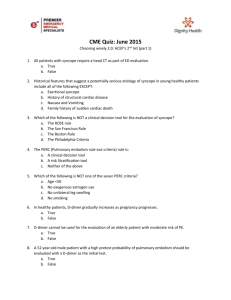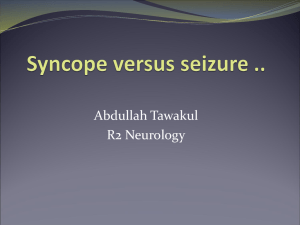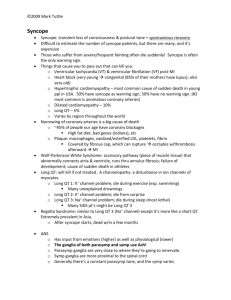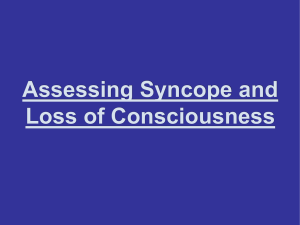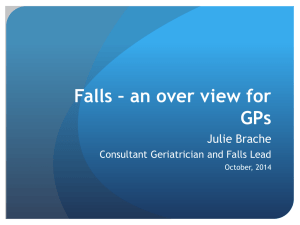Information for Patients with Syncope (Fainting Spells)
advertisement
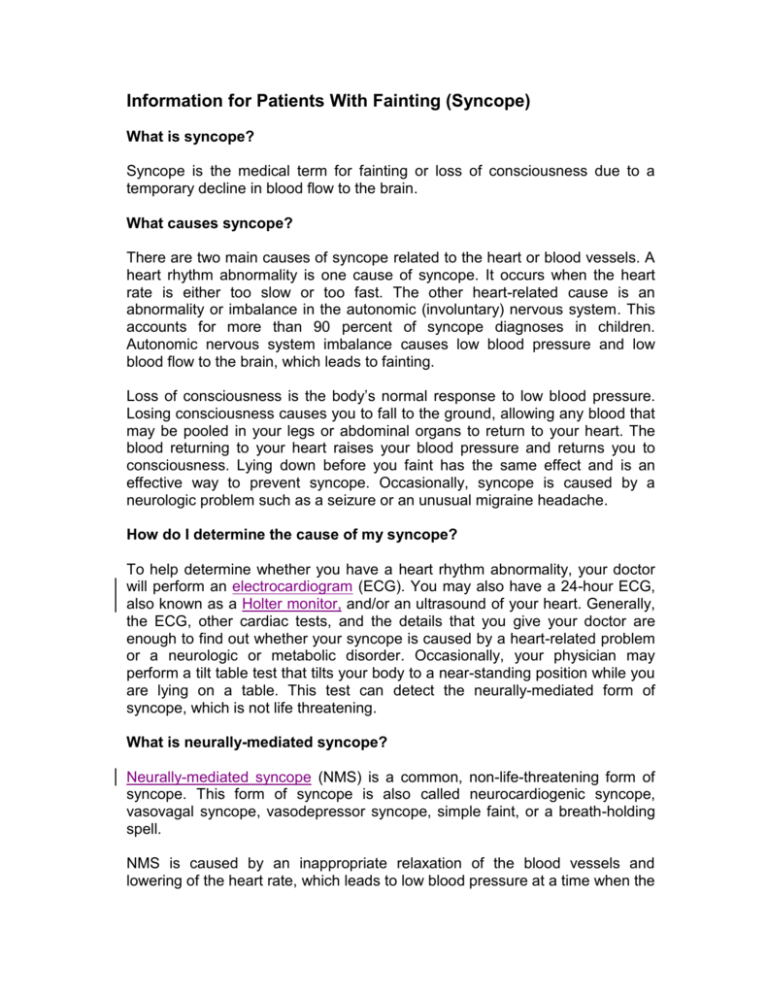
Information for Patients With Fainting (Syncope) What is syncope? Syncope is the medical term for fainting or loss of consciousness due to a temporary decline in blood flow to the brain. What causes syncope? There are two main causes of syncope related to the heart or blood vessels. A heart rhythm abnormality is one cause of syncope. It occurs when the heart rate is either too slow or too fast. The other heart-related cause is an abnormality or imbalance in the autonomic (involuntary) nervous system. This accounts for more than 90 percent of syncope diagnoses in children. Autonomic nervous system imbalance causes low blood pressure and low blood flow to the brain, which leads to fainting. Loss of consciousness is the body’s normal response to low blood pressure. Losing consciousness causes you to fall to the ground, allowing any blood that may be pooled in your legs or abdominal organs to return to your heart. The blood returning to your heart raises your blood pressure and returns you to consciousness. Lying down before you faint has the same effect and is an effective way to prevent syncope. Occasionally, syncope is caused by a neurologic problem such as a seizure or an unusual migraine headache. How do I determine the cause of my syncope? To help determine whether you have a heart rhythm abnormality, your doctor will perform an electrocardiogram (ECG). You may also have a 24-hour ECG, also known as a Holter monitor, and/or an ultrasound of your heart. Generally, the ECG, other cardiac tests, and the details that you give your doctor are enough to find out whether your syncope is caused by a heart-related problem or a neurologic or metabolic disorder. Occasionally, your physician may perform a tilt table test that tilts your body to a near-standing position while you are lying on a table. This test can detect the neurally-mediated form of syncope, which is not life threatening. What is neurally-mediated syncope? Neurally-mediated syncope (NMS) is a common, non-life-threatening form of syncope. This form of syncope is also called neurocardiogenic syncope, vasovagal syncope, vasodepressor syncope, simple faint, or a breath-holding spell. NMS is caused by an inappropriate relaxation of the blood vessels and lowering of the heart rate, which leads to low blood pressure at a time when the body actually needs constriction of the blood vessels and a slightly higher heart rate. These inappropriate changes in the heart and blood vessels are caused by an imbalance in the control of the autonomic (involuntary) nervous system that facilitates communication back and forth between the heart, blood vessels, and brain. Doctors do not completely understand the brain’s control of these involuntary signals and why some people develop NMS. How is NMS treated and prevented? NMS can be treated without drugs or medical intervention. Treatment includes hydration, recognition of warning symptoms, and use of antigravity measures. Hydration is the most effective way of preventing both dizziness and fainting. First, you should eliminate all caffeinated beverages from your diet. Caffeine increases the body’s production of urine, stimulates the heart, and makes fainting more likely to occur. If you drink large amounts of caffeinated beverages, you should eliminate them from your diet slowly, over a period of one to two weeks, to avoid excessive tiredness or headaches resulting from caffeine withdrawal. Second, increase your fluid intake and monitor your hydration by examining your urine color and frequency. If you are well hydrated, you will have to urinate more frequently and your urine color will be clear. If you are poorly hydrated, your urine will be dark yellow and you will urinate infrequently. If your urine color is not generally clear and your urination frequency is low, you can improve your hydration by drinking beverages that contain salt. Examples are Gatorade, Propel (which has fewer calories than Gatorade), and other sports drinks, and decaffeinated beverages such as ginger ale, Sprite, and most juices. Water is acceptable even though it does not contain salt. A rough guideline is to drink about 1 ounce for each pound of your body weight, up to around 90 to 120 ounces every day. Unless you have a problem with your kidney function or an elevated blood pressure, you should increase your salt intake, which you can do by eating non-fat salty foods such as pretzels and crackers. You should avoid eating salty foods that have added fat, such as chips. To help you increase your salt intake, your doctor may recommend you take salt tablets. You should discuss this treatment with your doctor to make sure it is right for you. It is important to remember that you will require more fluid during hot weather and/or if you are exercising, because you will lose more fluid at these times. If you are thirsty, you are already becoming dehydrated, so you should immediately drink more fluid. You may need to carry a bottle of water or another drink around with you during times when fluids are not readily available, such as during school. Even if prohibited in certain locations such as school, a note from your doctor should give you permission to have fluid with you at all times. It is hard to drink enough fluid from a water fountain to stay hydrated. Recognition is a very important step in avoiding syncope. You can avoid syncope by recognizing the symptoms that occur before syncope happens — a period known as pre-syncope — and taking measures to avoid completely fainting. Pre-syncope symptoms include dizziness or light-headedness; sweating; nausea; buzzing in the ears or a change in hearing; blurring, tunneling, or a loss of vision; and a pale or graycolored appearance that can be observed by others. If you have any of these symptoms, follow the antigravity maneuvers listed below to avoid fainting. Don’t try to walk to a school nurse’s office or outside because you might faint before arriving at your destination. A friend could accompany you out of a hot, crowded area. Antigravity maneuvers reduce the effect of gravity on the blood in your body. Gravity tends to pull blood down into the veins of your legs and the organs of your abdomen. As soon as you recognize the signs of presyncope, you should begin these maneuvers. The most effective of these is lying down on your back with your knees bent. Because lying down in certain situations can be difficult or embarrassing, a maneuver that is almost as effective is a low squat. Squatting brings your heart closer to your legs, returns much of the pooled blood to the heart, and blocks the arteries that carry blood to the legs. These changes raise the blood pressure in the rest of your body. A more subtle but somewhat less effective maneuver is crossing your legs while standing in place and tightening your abdominal muscles. This maneuver tends to work well during pre-syncope symptoms and may be particularly useful when standing still in a crowded setting. In addition, this maneuver can be used on a routine basis while standing around talking to people, and it may be very effective at preventing dizziness. Another subtle maneuver that is somewhat less effective than leg crossing is placing one foot on a stool or chair while the other one remains on the ground. Moving your legs in place may have a similar effect. If you can maintain the habit of good hydration, learn to recognize pre-syncope symptoms, and use antigravity maneuvers, you will probably avoid most fainting. What treatments are available if prevention methods don’t work for me? If the non-pharmacological maneuvers don’t work for you, a number of medications may be useful for preventing NMS. The most common drug prescribed for children and adolescents is Florinef. This mild steroid doesn’t have many of the side effects of common steroids such as prednisone. Florinef’s primary effect is to make your kidneys retain sodium and water. At standard doses it causes minimal weight gain and almost no detectable swelling. Possible side effects of Florinef are high blood pressure, which should be measured one to two weeks after you start taking the medication, and a mildly low potassium level, which can cause your legs to cramp. If you are prescribed Florinef, it is useful to increase your dietary potassium by eating bananas and other high potassium containing foods, and drinking fruit juices. Another class of medications that is sometimes used to treat NMS is beta blockers. Beta blockers include propranolol, atenolol, nadolol, metoprolol, and others. These medications block the effects of adrenaline on your heart and help prevent the abnormal reflex that leads to syncope. They are sometimes most useful for patients who have their symptoms during or after exercise. Side effects may include excess fatigue and tiredness. Most patients tolerate both Florinef and beta blockers without any problems. Another medicine that is used, midodrine, causes constriction of the blood vessels in the legs and increases blood pressure. If these therapies prescribed for you are not working, or if you have questions, please contact your physician. A Summary of How to Prevent NMS Without Medication 1. Maintain excellent hydration by drinking decaffeinated beverages and watching your urine color and frequency 2. Recognize your pre-syncope symptoms such as dizziness, lightheadedness, sweating, palpitations, etc. 3. Reverse the effects of gravity by: (a) Lying down with knees bent (b) Squatting (c) Crossing legs and tensing abdominal muscles (d) Placing one leg on a stool
